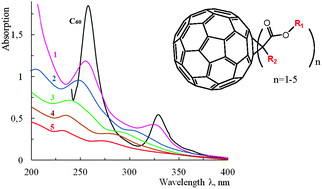Research into methanofullerenes with various substitution degrees by UV spectroscopy
Abstract
A qualitative and quantitative UV spectroscopic study of C60

* Corresponding authors
a
Chemistry Department, Bashkir State University, 32, Validy Str., Ufa, Russia
E-mail:
bn.yulya@mail.ru
Fax: +7-347-2299707
Tel: +7-347-2299729
b
Institute of Organic Chemistry, Ufa Scientific Center of the Russian Academy of Sciences, prosp. Oktyabrya, 71, Ufa, Russia
E-mail:
bioreg@anrb.ru
Fax: +7-347-2356066
Tel: +7-347-2356066
A qualitative and quantitative UV spectroscopic study of C60

 Please wait while we load your content...
Something went wrong. Try again?
Please wait while we load your content...
Something went wrong. Try again?
Y. N. Biglova, A. G. Mustafin, V. A. Kraikin and M. S. Miftakhov, New J. Chem., 2013, 37, 1358 DOI: 10.1039/C3NJ41098F
To request permission to reproduce material from this article, please go to the Copyright Clearance Center request page.
If you are an author contributing to an RSC publication, you do not need to request permission provided correct acknowledgement is given.
If you are the author of this article, you do not need to request permission to reproduce figures and diagrams provided correct acknowledgement is given. If you want to reproduce the whole article in a third-party publication (excluding your thesis/dissertation for which permission is not required) please go to the Copyright Clearance Center request page.
Read more about how to correctly acknowledge RSC content.
 Fetching data from CrossRef.
Fetching data from CrossRef.
This may take some time to load.
Loading related content
